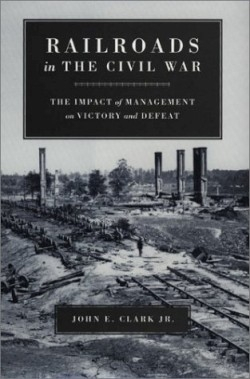Railroads in the Civil War
The Impact of Management on Victory and Defeat
“Sometime we skirted along the brow of a precipice where one might look down a sheer thousand feet into a sea of foliage of variegated hues, and anon we plunged into the midnight darkness of a tunnel, and then again into the bright sunshine.” These words were spoken by a Union Army soldier about his railroad trek in October of 1863.
It was an uplifting view for a war-weary soldier on his way to encounter an uncertain future. Such personal accounts keep the author’s examination of a little-researched topic—the use of railroads during the Civil War—from being a sterile analysis of the logistics of transporting men and supplies.
Clark posits that a Union victory was not inevitable, despite a supposed industrial and rail advantage. The Union simply administered their rail systems more quickly and more effectively than the Confederacy. In six chapters, Clark links the Confederacy’s mismanagement of its railroads directly to its ultimate defeat. He compares the Confederacy’s bumbled response and lack of centralized decision-making at the upper levels of government to the North’s swift precision and successful marriage of major railroad companies to highly organized government.
The focus of this work is the transfer of the 11th and 12th Corps of the Army of the Potomac to Chattanooga to re-enforce the Army of the Cumberland, who were starving under General’s Bragg’s stranglehold, after the battle of Chickamauga. Clark traces the intricate web of decision-making among Secretary of War Stanton, his generals in the field, and profit-driven rail moguls like John Garrett of the Baltimore and Ohio Railroad Company—a web that enabled the Union army to move twenty-three thousand soldiers and their equipment (including horses) across hundreds of miles in only twenty-three days. This short time included the transfer of all matériel from car to car when gauges of rails did not match across differing company lines.
The most interesting aspect of this work is the description of the soldiers’ personalities. While riding the rails to their next battle was a necessity, it was also an adventure for these men, who had witnessed great destruction. According to Dr. Hubbard of the 149th New Yorkers, soldiers solved the problem of overcrowding by tying themselves to the train’s roof to sleep, and holding “on to one another like a swarm of bees to avoid being shaken off.” Union ingenuity ran the entire chain of command, from soldier to government official. Simply put, the Union had “instant recognition of the fact situation, problem assessment, establishment of priorities and decisive actions.” The Confederacy did not.
Clark possesses a Ph.D. from Princeton in history and has been guided in his research by historian James McPherson. His research for this work includes an extensive bibliography that features scholarly manuscripts, periodicals, regimental histories, and correspondence.
Disclosure: This article is not an endorsement, but a review. The publisher of this book provided free copies of the book to have their book reviewed by a professional reviewer. No fee was paid by the publisher for this review. Foreword Reviews only recommends books that we love. Foreword Magazine, Inc. is disclosing this in accordance with the Federal Trade Commission’s 16 CFR, Part 255.

